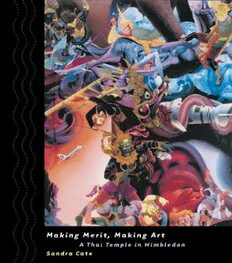
Making Merit, Making Art: A Thai Temple in Wimbledon PDF
265 Pages·2002·6.852 MB·English
Most books are stored in the elastic cloud where traffic is expensive. For this reason, we have a limit on daily download.
Preview Making Merit, Making Art: A Thai Temple in Wimbledon
Description:
Sandra Cate's pioneering ethnography of art-making at Wat Buddhapadipa, a Thai Buddhist temple in Wimbledon, England, explores contemporary art at the crossroads of identity, authority and value. Between 1984 and 1992, twenty-six young Thai artists painted a series of temple murals that continue to attract worshippers and tourists from around the world. Their work, both celebrated and controversial, depicts stories from the Buddha's lives in otherworldly landscapes punctuated with sly references to this-worldly politics and popular culture. Schooled in international art trends, the artists reverse an Orientalist narrative of the Asian Other, telling their own stories to diverse audiences and subsuming Western spaces into a Buddhist worldview. In her investigation of temple murals as social portraiture, Cate looks at the ongoing dialectic between the "real" and the "imaginary" as mural painters depict visual and moral hierarchies of sentient beings. As they manipulate indigenous notions of sacred space and the creative process, the Wat Buddhapadipa muralists generate complex, expansive visions of social place and identity. "What happens when a major project of Thai Buddhist art travels from its center in Bangkok to a significant periphery like London during the Asian economic miracles of the 1980s? Sandra Cate's meticulous and insightful account shows how relations between the local and the global, national identity and modernity, religion and art, monks and artists--almost everything--shifted "out of place." With this Thai global mission accomplished, long distance merit-making has changed the art-scape in Thailand. A remarkable book." --- Thongchai Winichakul, University of Wisconsin "This ethnography of mural painting at Wat Buddhapadipa--a Thai Buddhist temple in Wimbledon, England--is brilliantly conceived and executed, a model of what the new anthropology of art can be. The author should be commended for drawing the ruminations of the 1990s into a full-fledged work that teaches us a great deal about the circumstances of artistic production in the world today. She explores with understanding and acumen an emerging artworld that brings together a novel range of participants. The social and the visual each receive the specificity of attention they need, making the study engagingly full of the entanglements that so compellingly define artworlds and their actors. In turning our attention to mural paintings as mediations of Thai Buddhism, mediations sensitive to institutional and cultural context, Sandra Cate recognizes a vital dimension of art and social theory, the mutual constitution of subjects and objects." --- Fred Myers, New York University
See more
The list of books you might like
Most books are stored in the elastic cloud where traffic is expensive. For this reason, we have a limit on daily download.
